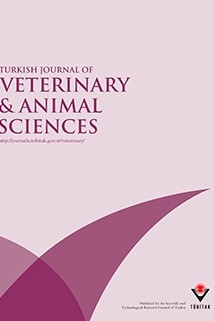
Turkish Journal of Veterinary and Animal Sciences
Yazarlar: Çağatay TEK, Ahmet SABUNCU
Konular:-
Anahtar Kelimeler:Postpartum dairy cow,GnRH,HCG,PGF2a,Oestrus synchronization,Fertility
Özet: The aim of this study was to determine the effect of GnRH + PGF2a and hCG + PGF2a applications on oestrus and fertility in dairy cows postpartum between days 35 and 45. In this study, 117 healthy, 3-7-year-old Holstein dairy cows from the same farm under similar husbandry conditions were used and they were in postpartum days between 35 and 45. Cows were divided equally into three groups randomly. Group I (n = 39): on day 0, 2000 IU hCG IM (PregnylR, Organon) was given, on day 7, 500 mg Cloprostenol Na IM (EstrumateR, DİF), and on day 9, 12.6 mg Buserelin acetate IM (ReceptalR, Hoechst). Group II (n = 39): on day 0, 12.6 mg Buserelin acetate IM (ReceptalR, Hoechst) was given, on day 7, 500 mg Cloprostenol Na IM (EstrumateR, DİF), and on day 9, 2000 IU hCG IM (PregnylR, Organon). Group III (n = 39): they received 500 mg Cloprostenol IM (EstrumateR, DİF) twice, at 11-d intervals. The diameters of the follicules in ovaria were measured in the cows in groups I and II on day 9, and in the cows in group III 48 h after the second Cloprostenol Na application, using transrectal ultrasonography. The cows in groups I and II were artificially inseminated 12 and 24 h after applications on day 9. The cows in group III were artificially inseminated 60 and 84 h after the second Cloprostenol application. On day 28 and day 55 after insemination, pregnancy was diagnosed using transrectal ultrasonography. No statistical differences were found between the cows in groups I and II and the cows in groups II and III in terms of dominant follicule, pregnancy and embryonic death on day 28 and day 55 (p > 0.01). The rates of pregnancy between groups I and III on day 28 and the cows in the same groups which have dominant follicule on day 28 and day 55 differ statistically, being positive for group I (p < 0.01). No statistical differences were found between groups I and III for parameters of dominant follicule, pregnancy and embryonic death on day 55 (p > 0.01). In this study it was found that there were no statistical differences among the three groups in terms of showing oestrus and it was also found that application of GnRH, to stimulate ovulation, before insemination and pregnancy resulted in similar findings as hCG application. However, group I had higher pregnancy rates (statistically significant) than group III, which did not receive hormones before insemination. These results indicate that it will be useful to apply GnRH before insemination to increase pregnancy rates.